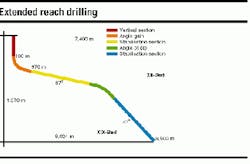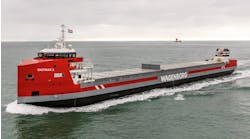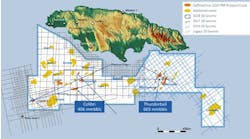DIRECTIONAL DRILLING: Sakhalin group building output with fast low-cost directional wells
Russia's oil industry is developing new skills in deviated drilling on a series of small reservoirs offshore Sakhalin Island. Stepan Zemluk, Vice-President of Rosneft-SMNG, outlined progress to date at IBC's recent Sakhalin Oil and Gas Conference in London.
The oil-condensate Odoptu-Sea Field was discovered in 1977 in the far north of the Piltun Gulf, 4-10 km off the east coast of Sakhalin Island. The 32-km-by-6-km structure is a three-dome (Northern, Central and Southern) anticlinal fold. The water depth on the western flank of the Northern Dome is around 18 meters.
During the 1977-82 period, 15 wells were drilled into the three domes from floating drilling rigs. In 1993, Sakhalinmorneftegaz Production Association was granted development rights by the Committee of the Russian Federation for geology and use of subsoil. Subsequently, the Northern Dome was excluded from the Sakhalin I PSA awarded to Exxon and Sodeco.
Initially, the Odoptu-Sea consortium of SakhalinNIPImorneft, VNIPImorneftegaz, and Sodeco envisaged a conventional development based around fixed offshore ice-resistant installations with subsea pipelines, but it soon transpired that the huge capital expenditure needed, $200 million, would render the scheme unviable.
Building experience
By 1995, Rosneft-Sakhalinmorneftegaz had built up experience with horizontal wells on fields onshore Sakhalin. However, at that point, Russia still lacked the technology to drill wells with extreme deviation from the vertical, Zemlyuk said. The solution was to drill extended reach wells from a shore location into Odoptu-Sea's Northern Dome.
Once drilling facilities had been installed at a point on the sea spit, the first well (202) was spudded in June 1997 and completed in July 1998. The exercise was successful, with no hitches or complications. The deviation angle at bottom-hole from the vertical was 88 degrees. Total length of the well was 5,590 meters. The section deviated from vertical was 4,780 meters.
A geophysical survey conducted during drilling had facilitated a reliable layer-by-layer correlation of the well cut, Zemlyuk claimed, confirming oil saturation of certain zones and also a previously undiscovered field, boosting recoverable reserves by 5 million tons. In August 1998, the newly drilled well (202) flowed 220 ton/day of water-free oil, marking the start of commercial production on the Sakhalin Shelf.
201/203 well
Subsequently, well 201/203 was commissioned in April 2000. This differed from well 202 in its borehole trajectory, which featured a dual bottomhole design. This allows depression on the seabed to decrease, Zemlyuk said, thereby extending the duration of water-free well operation.
The well's parameters exceeded those of its predecessor, with a deviation from the vertical depth (1,570 meters) of almost 5,000 meters, and a total borehole length of 5,760 meters. It also was assembled much more quickly - 240 days, compared with 358 for well 202. Oil flow rate, however, is lower, at 200 tons/day.
By mid-November, the Rosneft-Sakhalinmorn-eftegaz consortium was close to completing a third-oil producer in the Northern Dome with a deviation from the vertical of 5,500 meters, at a vertical depth of 1,600 meters with a planned flow rate of 300 tons/day. Well construction time was predicted to be shorter, and the aim for the next scheduled well (204) is 140 days. Zemlyuk claimed that deviation values achieved from the vertical accord with best international practice.
Aiming for 270,000 tons
Recently, the consortium has undertaken further construction works so that the drilling equipment can be transferred to a new site on the sea spit, four km south of the northern drill center. From there, the plan is to drill three wells into the southern offshore well cluster. Once these have been completed, the field should be producing 270,000 tons/yr of oil.
"The new method of development of the Sakhalin offshore fields, located near the ecologically sensitive coast of the Okhotsk Sea, allowed us to drastically cut expenditures when compared to traditional methods of equipping fields with offshore fixed facilities," according to Zemlyuk. Building a platform, plus related sealines, would have increased the project cost by four to five times the current total, he suggested.
"During the project we managed to eliminate and remove all ecological risks concerning the development of the field that could have taken place during oil production from offshore fixed facilities. Moreover, we have gained experience in drilling incline-directed wells with super-far deviation from the vertical line and obtained important information on potential offshore fields which makes it possible to improve the reliability of initial parameters for the designing of such developments."
Central Dome status
Concurrent with the Northern Dome development, Sakhalinmorneftegaz also performed a feasibility study for producing the gas-condensate reserves from Odoptu-Sea's Central Dome via five deviated wells drilled from land. The product would then feed into the planned gasification program for the Russian Far East, along with supplies from upcoming developments of other fields in the Sakhalin I and II PSAs.
According to the State Commission on Reserves, the Central Dome has an estimated 28 bcm of free gas and 900,000 tons of condensate. The field exhibits a straightforward geological structure, with four producing formations at a depth of 1,000-1,300 meters. During tests, gas has flowed at up to 260,000 cu meters/day.
Well construction will incorporate experience from the Northern Dome campaign, however, a three-column well design is proposed to avoid potential complications during drilling, Zemlyuk said.
Rosneft-Sakhalinmorneftegaz sees further potential in tectonic blocks in the southern pericline of the Astrakhanovskoya-Sea formation, in locations up to 5.5 km from the shore.




